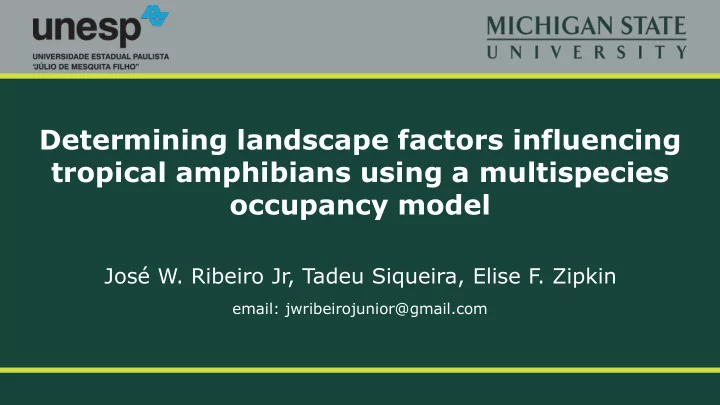

Determining landscape factors influencing tropical amphibians using a multispecies occupancy model José W. Ribeiro Jr, Tadeu Siqueira, Elise F. Zipkin email: jwribeirojunior@gmail.com
I NTRODUCTION Why Amphibians? Proportion of species 0.0 0.2 0.4 0.6 0.8 1.0 Amphibians Cartilaginous fish Mammals Critically endangered Reptiles Endangered Bony fish Vulnerable Birds Data Deficient Least concern + Near threatened Hoffmann et al. 2010, IUCN 2016
I NTRODUCTION Forest loss DEFORESTATION AGRICULTURE NATURAL FOREST ➢ Major driver of biodiversity loss Figures credit: http://blog.globalforestwatch.org Collins and Crump 2009, Gámez-Virués et al. 2015
I NTRODUCTION Habitat fragmentation AGRICULTURE DEFORESTATION NATURAL FOREST Matrix Forest habitat Forest patch Fahrig 2003
I NTRODUCTION Habitat fragments AGRICULTURE DEFORESTATION NATURAL FOREST ➢ Alters vegetation composition ➢ Increase light ➢ Increase temperature ➢ Decrease water quality Collins and Crump 2009, Ewers and Banks-Leite 2013, Clément et al. 2017
I NTRODUCTION Matrix matters AGRICULTURE TREE PLANTATION Prevedello and Vieira 2010, Ferrante et al. 2017
I NTRODUCTION Stream density ➢ Proxy for habitat amount ➢ Increase connectivity between aquatic habitats Ficetola et al. 2009, 2011
I NTRODUCTION Catchment area and Slope ➢ Physical habitat ▪ Substrate type ▪ Stream size ➢ Variation in vegetation Parris and McCarthy 1999, Eterovick and Barata 2006, Keller et al. 2009, Ribeiro et al. 2012
I NTRODUCTION Catchment area and Slope Slope ➢ Physical habitat Catchment area ▪ Substrate type ▪ Stream size ➢ Variation in vegetation height difference / horizontal distance Parris and McCarthy 1999, Eterovick and Barata 2006, Keller et al. 2009, Ribeiro et al. 2012
I NTRODUCTION Why Brazilian Atlantic Rainforest Amphibians? Source: http://biodiversitymapping.org
I NTRODUCTION Why Brazilian Atlantic Rainforest Amphibians? Threatened Amphibians Endemic Amphibians Data Deficient Amphibians Source: http://biodiversitymapping.org
I NTRODUCTION Brazilian Atlantic Forest ➢ Atlantic Forest originally covered >1,450,000 km 2 ➢ ~15% of forest remains ▪ 14% is protected by nature reserve Ribeiro et al. 2009, Joly et al. 2014
G OAL Investigate the influence of landscape characteristics on amphibian occurrence probabilities in Brazilian Atlantic Forest streams
E XPECTATIONS Forest cover and Stream density Occurrence probability Forest cover and Stream density
E XPECTATIONS Agriculture Occurrence probability Agriculture
E XPECTATIONS Catchment area and Slope Occurrence probability Catchment area and Slope
S TUDY AREA Forest (69%) Silviculture (19%) Agriculture (11%) Streams State Park
A MPHIBIAN SAMPLING Active - Standardized Acoustic and Passive - Automated Acoustic Visual Transect Sampling (SAVTS) Recorders (AAR) rainy season (Oct 2015 - Mar 2016)
A MPHIBIAN SAMPLING Active method - SAVTS ➢ 100 m transect segment ➢ Stream channel, vegetation, and litter ➢ Recorded all calling individuals ➢ Each stream was sampled twice Parris 2004, Alix et al. 2014, Walls et al. 2014
A MPHIBIAN SAMPLING Passive method - AAR ➢ Automated Acoustic Recorders ➢ 1.5 m above the ground ➢ 5-min periods each hour from 4-11 pm ➢ During three days Parris 2004, Alix et al. 2014, Walls et al. 2014
M ULTI - SPECIES MODEL Forest cover Occupancy model Agriculture ~ Occupancy Catchment area Stream density Slope logit link function Dorazio and Royle 2005, Zipkin et al. 2009, Kéry and Royle 2015
M ULTI - SPECIES MODEL Detection model Date - linear Method type + Detection ~ Date - square Precpitation logit link function Dorazio and Royle 2005, Zipkin et al. 2009, Kéry and Royle 2015
M ULTI - SPECIES MODEL Community-level paramater ➢ Use a community-level distribution (hyper-distribution) ➢ Normal distribution Dorazio and Royle 2005, Zipkin et al. 2009, Iknayan et al. 2014, Kéry and Royle 2015
R ESULTS Community-level occupancy Posterior distribution not overlapping zero < 75% 75 - 95% > 95%
R ESULTS Community-level occupancy Posterior distribution not overlapping zero < 75% 75 - 95% > 95%
R ESULTS Community-level occupancy 92% Posterior distribution not overlapping zero < 75% 75 - 95% > 95%
R ESULTS Community-level occupancy Posterior distribution not overlapping zero < 75% 75 - 95% > 95%
Forest cover Stream density R ESULTS Species-level occupancy Species Species Posterior distribution not overlapping zero < 75% 75 - 95% > 95%
Agriculture Catchment area Slope R ESULTS Species-level occupancy Species Posterior distribution not overlapping zero < 75% 75 - 95% > 95%
R ESULTS Detection process ➢ Average detection varied widely (0.01 – 0.88) Active Passive ➢ Influenced by the method ➢ Peaked middle of the rainy season
R ESULTS Community-level detection Active Passive
C ONCLUSIONS ➢ On average, small streams and flat topographic areas increase the amphibian occurrence probabilities ➢ Forest fragments can maintain amphibian diversity in a forested dominated landscape ➢ Agriculture has a negative impact on amphibians
A CKNOWLEDGEMENTS The São Paulo Research Foundation Grants: 2014/07113-8 and 2016/07469-2 BIODIVERSITY ANALYSIS & SYNTHESIS LAB Universidade Estadual Paulista (UNESP)
Recommend
More recommend